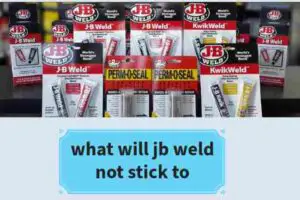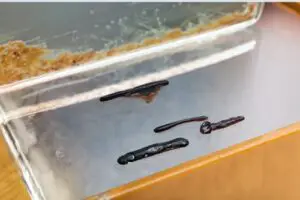Table of Contents
- A Quick Look at JB Weld
- Understanding Adhesion Properties
- Areas JB Weld Might Not Stick To
- Exploring Unlikely Surfaces
- Best Practices and Alternatives
- Tips for Maximizing JB Weld’s Adhesion
- Will J-B Weld Stick to Anything?
- Will J-B Weld Stick to Metal and Plastic?
- Is J-B Weld a Permanent Fix?
- Will J-B Weld Stick to Silicone?
- Can J-B Weld Get Wet While Curing?
- Is J-B Weld Oil Resistant?
- Can Acetone Remove J-B Weld?
- JB Weld, Does it Work?
- Conclusion
- FAQs For What Will JB Weld Not Stick To?
JB Weld is known for its reliable fixing, but what will JB Weld not stick to? This epoxy is a go-to for almost any fix, yet there are rare cases where it won’t hold.
Discover the secrets of JB Weld’s bonding strengths and where they might falter. Delve into adhesion limitations and alternative solutions, ensuring your repairs stand firm.
Remember that JB Weld may have difficulty sticking to specific plastic, rubber, or highly oily or greasy materials.
A Quick Look at JB Weld
JB Weld is a stalwart in adhesives, revered for its exceptional bonding capabilities and widespread application in various repair projects. This two-part epoxy adhesive has gained immense popularity due to its strength, versatility, and durability.
What is JB Weld?
JB Weld comprises two components – a resin and a hardener – which create a potent adhesive when mixed in equal proportions. It forms a strong bond upon curing, making it ideal for repairs in many materials like metal, wood, plastic, ceramics, glass, and more.
Its Widespread Use in Repairs
The versatility and strength of JB Weld have made it a household name in repair projects. JB Weld applies to a broad spectrum of materials, from patching cracks in metal surfaces to mending broken ceramics. It’s the go-to solution for DIY enthusiasts, professionals, mechanics, craftsmen, and hobbyists alike.
Whether it’s fixing automotive parts, sealing leaks in plumbing, or reinforcing wooden structures, JB Weld’s reliability and durability have earned it a reputation as a dependable adhesive for various repair needs.
This adhesive’s ability to withstand extreme temperatures and provide long-lasting solutions has cemented its place in countless repair projects globally, making it a trusted companion for those seeking robust and lasting fixes.
Understanding Adhesion Properties
Adhesion is the fundamental principle behind any adhesive’s effectiveness, including JB Weld. It’s crucial to comprehend the factors that influence adhesion to understand where JB Weld excels and where it might face challenges.
Factors Affecting Adhesion
- Surface Preparation: The key to successful adhesion is adequately preparing the surface. Surfaces must be clean and roughened for enhanced bonding and devoid of oils, dirt, or rust.
- Material Compatibility: JB Weld exhibits remarkable versatility, bonding well with metals, ceramics, wood, and many plastics. However, it might struggle with materials with low surface energy, like polyethylene or polypropylene, hindering the adhesive’s ability to form a strong bond.
- Environmental Conditions: Temperature, humidity, and curing time significantly impact adhesion. Ideal conditions promote proper curing and optimal bond strength.
Surfaces Where JB Weld Works Well
JB Weld’s prowess in adhering to various surfaces makes it a favored choice in repair projects. It excels in:
- Metal Repairs: JB Weld is renowned for its exceptional bond on metal surfaces, making it valuable in fixing cracks, holes, or bonding metal parts.
- Woodwork: Whether repairing furniture or bonding wooden components, JB Weld offers reliable adhesion.
- Plastic Repairs: While it works well with many plastics, it’s essential to note the limitations on surfaces with low surface energy.
Understanding these adhesion properties helps users leverage JB Weld effectively, ensuring optimal bonding and successful repair projects across various materials and surfaces.
Areas JB Weld Might Not Stick To
While JB Weld is renowned for its exceptional bonding capabilities, there are specific surfaces and conditions where it might encounter challenges in achieving the desired adhesion. Understanding these limitations is crucial for practical application and successful repairs.
Types of Surfaces JB Weld Struggles With
- Non-Porous Materials: Surfaces with low surface energy, such as polyethylene or polypropylene, pose a challenge for JB Weld. These materials inherently resist bonding due to their molecular structure, making it difficult for the adhesive to form a strong bond.
- Surfaces Contaminated with Oil or Grease: Oil or grease on surfaces can act as a barrier, inhibiting JB Weld’s ability to adhere effectively. Properly cleaning and degreasing the surface beforehand is essential for improved adhesion.
- Highly Smooth or Polished Surfaces: Extremely smooth surfaces or high polish, such as Teflon coatings or silicone, can be challenging for JB Weld to adhere to due to their non-stick properties.
Exploring Unlikely Surfaces
- Teflon and Silicone Coatings: JB Weld might struggle to bond with surfaces coated with Teflon or silicone due to their low surface energy and non-stick properties, making them unsuitable for solid adhesion.
- Epoxy or Oil-Based Paints: Certain coatings, especially those containing epoxy or oil-based elements, may not offer the necessary surface compatibility for JB Weld to form a robust bond.
Understanding these limitations helps users identify scenarios where JB Weld might not perform optimally. However, it’s important to note that despite these challenges, there are strategies and alternative approaches to overcome these limitations for successful repairs.
Exploring Unlikely Surfaces
While JB Weld is renowned for its strong adhesion to various materials, there are specific surfaces or coatings where its effectiveness might be limited. Understanding these instances helps in making informed decisions during repair projects.
Specific Materials or Coatings Where JB Weld Might Not Adhere
- Teflon Coatings: Surfaces coated with Teflon, known for their non-stick properties, present challenges for JB Weld’s adhesion. The low surface energy of Teflon inhibits the adhesive from forming a solid bond.
- Silicone Surfaces: Similar to Teflon, silicone surfaces possess non-stick properties, making them resistant to JB Weld’s adhesion. These surfaces might require alternative bonding methods.
- Certain Plastics: While JB Weld generally bonds well with many plastics, some, like polyethylene and polypropylene, possess low surface energy, making adhesion difficult.
Explanations for These Instances
The challenge with these surfaces lies in their inherent properties, particularly their low surface energy and non-porous nature. JB Weld requires a surface that allows it to create a strong bond by penetrating and adhering to the material.
Surfaces with low energy or non-stick properties resist this process, limiting the adhesive’s effectiveness.
Overcoming Challenges
While JB Weld might not adhere well to these surfaces, there are alternative approaches for repair:
- Mechanical Fasteners: Utilizing screws, bolts, or other mechanical fasteners can provide a secure bond in cases where JB Weld struggles to adhere.
- Specialized Adhesives: Exploring adhesives specifically designed for these surfaces or coatings might offer better bonding solutions.
By recognizing these limitations and exploring alternative methods, users can effectively address repair needs even when JB Weld encounters difficulties adhering to specific materials or coatings.
Best Practices and Alternatives
While JB Weld is a versatile adhesive, encountering surfaces where it struggles to adhere is not uncommon. Implementing specific practices and exploring alternative solutions can help overcome these challenges, ensuring successful repairs.
Tips for Maximizing JB Weld’s Adhesion
- Surface Preparation: Thoroughly clean and degrease surfaces before applying JB Weld. Roughen the surface to enhance bonding by using sandpaper or abrasives.
- Proper Mixing: Follow the manufacturer’s instructions for mixing the epoxy and hardener in the correct proportions. A precise mixture is crucial for optimal bonding.
- Temperature and Curing Conditions: Ensure the application temperature falls within the recommended range and provide adequate curing time for the adhesive to set correctly.
- Adhesion Promoters: Consider using adhesion promoters or primers specifically formulated to enhance JB Weld’s bonding on challenging surfaces.
Alternative Options for Challenging Surfaces
- Mechanical Fasteners: When JB Weld struggles to adhere, using mechanical fasteners like screws or bolts can provide a reliable alternative for securing materials.
- Specialized Adhesives: Explore other specialized adhesives designed explicitly for surfaces where JB Weld might not perform well. These adhesives might offer better compatibility and bonding capabilities.
- Epoxy Putty or Fillers: For specific applications, epoxy putty or fillers can serve as viable alternatives, especially when traditional adhesives face limitations.
By implementing these best practices and considering alternative solutions, individuals can maximize the effectiveness of JB Weld in most repair scenarios.
However, understanding the limitations and having alternative options is valuable for handling challenging surfaces or materials where JB Weld’s adhesion might be less effective.
Will J-B Weld Stick to Anything?
J-B Weld’s remarkable bonding properties might leave you wondering if it can stick to virtually anything. While it boasts impressive versatility, certain surfaces pose challenges for this adhesive powerhouse. Understanding these limitations can save you time and frustration in your projects.
Will J-B Weld Stick to Metal and Plastic?
Regarding metal and plastic, J-B Weld excels in most cases. It forms a solid and durable bond on various metals and plastics, making it ideal for automotive, plumbing, and household repairs.
However, it’s essential to note that not all metal and plastic surfaces are created equal. Smooth and clean surfaces yield the best results, as J-B Weld requires a solid base to create its unbreakable link.
Is J-B Weld a Permanent Fix?
J-B Weld is often hailed for its resilience and long-lasting hold, but whether it provides a permanent fix depends on the context. In scenarios where the bonded materials are subjected to continuous stress, extreme temperatures, or harsh chemicals, the longevity of the bond may be compromised over time.
It’s advisable to assess the specific requirements of your project and consult the manufacturer’s recommendations for optimal results.
Will J-B Weld Stick to Silicone?
Silicone, known for its smooth texture and water-resistant properties, can be a tricky surface for adhesives. J-B Weld, although versatile, may not provide its usual robust bond on silicone. The chemical composition of silicone can hinder the adhesive’s ability to create a secure connection.
While it might adhere temporarily, the bond could be weaker than other materials. Exploring alternative bonding methods designed for this material is advisable when dealing with silicone.
Can J-B Weld Get Wet While Curing?
One concern frequently arises when using a J-B Weld is its reaction to moisture during curing. Unlike some highly sensitive adhesives, j-B Weld is relatively resilient to water exposure.
While keeping the curing area dry is recommended, minor exposure to moisture during the curing period is unlikely to affect the adhesive’s performance significantly. However, ensuring a dry environment during curing is still advisable for optimal results.
Is J-B Weld Oil Resistant?
The resistance of J-B Weld to oil is a critical consideration, especially for applications in automotive and mechanical settings. J-B Weld exhibits some oil resistance, making it suitable for projects where contact with oils and lubricants is expected.
However, the resistance level can vary based on factors such as the type of oil and the specific conditions of use. It’s essential to assess the compatibility of the J-B Weld with the particular oil or lubricant you intend to encounter in your application.
Can Acetone Remove J-B Weld?
Acetone, a potent solvent known for dissolving various substances, might seem a viable option for removing adhesives. However, when it comes to J-Beld, the situation is not as straightforward. J-B Weld is a two-part epoxy adhesive that cures to form a robust and durable bond. This chemical reaction results in a molecular structure resistant to many solvents, including acetone.
While acetone can weaken or soften certain adhesives, its effectiveness against cured J-B Weld is limited. The molecular cross-linking within J-B Weld’s structure contributes to its exceptional strength, making it less susceptible to the dissolving effects of acetone. Therefore, removing fully cured J-B Weld with acetone is unlikely to yield significant results.
JB Weld, Does it Work?
Conclusion
In conclusion, JB Weld is a formidable adhesive, offering reliable solutions for various repair needs. While it exhibits remarkable bonding capabilities across many materials, understanding its limitations on certain surfaces is crucial for successful application. Users can navigate these limitations by recognizing where JB Weld might face challenges and implementing best practices.
Additionally, exploring alternative solutions when JB Weld struggles to adhere ensures that repair projects culminate in durable and lasting fixes. Despite its exceptional versatility, being aware of JB Weld’s strengths and limitations empowers users to achieve optimal results in their repair endeavors.
FAQs For What Will JB Weld Not Stick To?
Can JB Weld be sanded and painted?
Yes, once cured, JB Weld can be sanded and painted to match the surrounding surface.
Is JB Weld heat-resistant?
JB Weld can withstand high temperatures, but its resistance varies based on the specific product. Always check the manufacturer’s guidelines.
Can I use JB Weld on outdoor projects?
While JB Weld is weather-resistant to some extent, prolonged exposure to outdoor elements may degrade its bond over time.
Is there a shelf life for JB Weld?
Yes, JB Weld has a shelf life. Be sure to check the expiration date before use.
Can I speed up the curing process of JB Weld?
It’s best to follow the recommended curing time for optimal bonding. Accelerating the process may compromise the strength of the bond.



3 thoughts on “What Will JB Weld Not Stick To?”